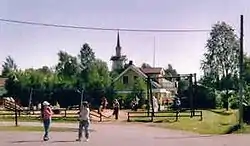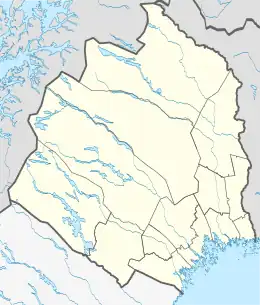Pajala | |
|---|---|
 Pajala Church, July 2004 | |
 Pajala | |
| Coordinates: 67°11′N 23°22′E / 67.183°N 23.367°E | |
| Province | Norrbotten |
| County | Norrbotten County |
| Municipality | Pajala Municipality |
| Area | |
| • Total | 3.78 km2 (1.46 sq mi) |
| Population (31 December 2010)[1] | |
| • Total | 1,958 |
| • Density | 518/km2 (1,340/sq mi) |
| Time zone | UTC+1 (CET) |
| • Summer (DST) | UTC+2 (CEST) |
Pajala (Swedish pronunciation: [ˈpɑjɑlɑ]) is a locality and the seat of Pajala Municipality in Norrbotten County, Sweden, with 1,958 inhabitants in 2010.[1] It is located in Swedish Lapland.
Pajala is in the Torne Valley and was dominated by people speaking a Finnish dialect until Eastern Sweden (Finland) got annexed by Russia in the 1800s and Pajala ended on the Swedish side of the river that marked the border. Today the town is nearly unilingually Swedish although the Meänkieli name for the locality remains in use and is a minority language. Even so, Pajala has belonged to Sweden since the country's inception as a political unit.
History
Lars Levi Laestadius, a botanist, Lutheran minister, and founder of the revivalist movement Laestadianism, lived and worked in Pajala municipality in the mid-19th century. He lived in Kengis, but in 1869 his house and grave and the whole church of Kengis were moved to Pajala.[2]
The town was mistakenly bombed by Soviet airplanes during the Finnish/Soviet Winter War, in spring 1940. Seven Soviet planes dropped 134 bombs, a mix of explosive and firebombs, which destroyed six buildings, badly damaging telephone wires, and making the streets impossible to drive on due to 43 big craters. No human deaths were recorded, although two persons were slightly injured.[3] Soviet officers later inspected the destruction and the Soviet Union paid damages to Sweden in 1940.
Literature about Pajala
The events in Mikael Niemi's book "Populärmusik från Vittula" (Popular Music from Vittula) occur mainly in Pajala. Vittula, or more properly Vittulajänkkä, is a colloquial name (vulgar in its Finnish-Sami etymology, roughly translating to "The pussy swamp") for a certain garden suburb in Pajala. The book was also adapted into a film in 2004.
In another portrait of Pajala by Niemi, the crime novel "Mannen som dog som en lax" ("The Man who Died like a Salmon"), the author discusses the state of the minority language Meänkieli in Pajala today.
Climate
Pajala has a harsh subarctic climate[4] that is somewhat moderated by the influence of the North Atlantic. Its inland position and lower elevation cause warmer summers, and winters are a bit less cold than most areas on similar latitudes.
| Climate data for Pajala (2002–2020 averages; extremes since 1940) | |||||||||||||
|---|---|---|---|---|---|---|---|---|---|---|---|---|---|
| Month | Jan | Feb | Mar | Apr | May | Jun | Jul | Aug | Sep | Oct | Nov | Dec | Year |
| Record high °C (°F) | 7.6 (45.7) |
8.7 (47.7) |
10.8 (51.4) |
18.8 (65.8) |
28.0 (82.4) |
32.0 (89.6) |
31.7 (89.1) |
29.1 (84.4) |
23.8 (74.8) |
15.3 (59.5) |
10.0 (50.0) |
8.4 (47.1) |
32.0 (89.6) |
| Mean maximum °C (°F) | 1.6 (34.9) |
3.5 (38.3) |
7.0 (44.6) |
13.2 (55.8) |
22.8 (73.0) |
25.3 (77.5) |
26.5 (79.7) |
25.1 (77.2) |
19.0 (66.2) |
11.1 (52.0) |
4.5 (40.1) |
3.0 (37.4) |
27.9 (82.2) |
| Mean daily maximum °C (°F) | −8.5 (16.7) |
−6.8 (19.8) |
−0.9 (30.4) |
5.2 (41.4) |
12.1 (53.8) |
17.2 (63.0) |
20.6 (69.1) |
18.0 (64.4) |
12.0 (53.6) |
3.5 (38.3) |
−2.5 (27.5) |
−5.1 (22.8) |
5.4 (41.7) |
| Daily mean °C (°F) | −13.4 (7.9) |
−11.9 (10.6) |
−6.7 (19.9) |
0.1 (32.2) |
6.4 (43.5) |
11.8 (53.2) |
14.8 (58.6) |
12.4 (54.3) |
7.3 (45.1) |
0.0 (32.0) |
−6.4 (20.5) |
−9.6 (14.7) |
0.4 (32.7) |
| Mean daily minimum °C (°F) | −18.2 (−0.8) |
−17.0 (1.4) |
−12.5 (9.5) |
−5.1 (22.8) |
0.7 (33.3) |
6.3 (43.3) |
9.0 (48.2) |
6.8 (44.2) |
2.5 (36.5) |
−3.5 (25.7) |
−10.2 (13.6) |
−14.0 (6.8) |
−4.6 (23.7) |
| Mean minimum °C (°F) | −33.3 (−27.9) |
−32.6 (−26.7) |
−28.2 (−18.8) |
−17.7 (0.1) |
−6.5 (20.3) |
−0.5 (31.1) |
1.6 (34.9) |
−1.9 (28.6) |
−5.7 (21.7) |
−17.0 (1.4) |
−24.5 (−12.1) |
−29.2 (−20.6) |
−35.5 (−31.9) |
| Record low °C (°F) | −45.2 (−49.4) |
−43.2 (−45.8) |
−40.0 (−40.0) |
−29.1 (−20.4) |
−14.3 (6.3) |
−4.0 (24.8) |
−1.7 (28.9) |
−5.8 (21.6) |
−13.9 (7.0) |
−26.0 (−14.8) |
−36.5 (−33.7) |
−38.7 (−37.7) |
−45.2 (−49.4) |
| Average precipitation mm (inches) | 37.4 (1.47) |
27.7 (1.09) |
21.5 (0.85) |
24.7 (0.97) |
44.7 (1.76) |
59.1 (2.33) |
75.7 (2.98) |
57.3 (2.26) |
55.4 (2.18) |
40.8 (1.61) |
43.9 (1.73) |
40.7 (1.60) |
528.9 (20.83) |
| Source: SMHI[5] | |||||||||||||
References
- 1 2 3 "Tätorternas landareal, folkmängd och invånare per km2 2005 och 2010" (in Swedish). Statistics Sweden. 14 December 2011. Archived from the original on 27 January 2012. Retrieved 10 January 2012.
- ↑ Svenska kyrkans information om Pajala Kyrka Archived 2011-10-05 at the Wayback Machine
- ↑ Time - "Darkening Up Here'
- ↑ "Pajala, Sweden Climate Summary". Weatherbase. Retrieved 11 April 2015.
- ↑ "Statistik från väder och vatten - Månads och årsstatistik" (in Swedish). Swedish Meteorological and Hydrological Institute. Retrieved 11 March 2021.